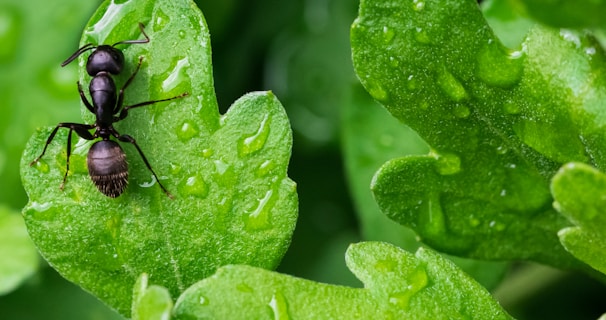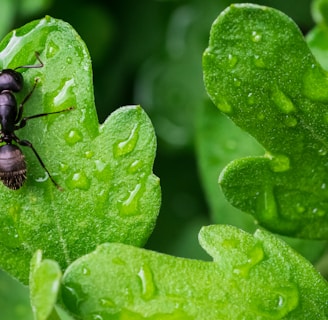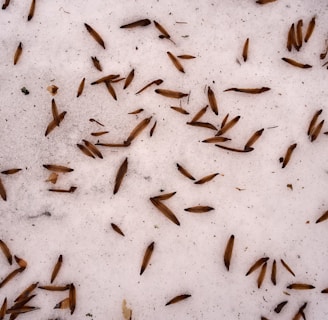Differences Between Termite Swarmers and Ant Swarmers
Unraveling the Distinctions: Learn How to Tell Apart Termite Swarmers and Ant Swarmers, Key to Effective Pest Identification and Control. Call today (401) 390-2080 for a free quote!
NE REGION PEST CONTROLTERMITE CONTROLRESIDENTIAL PEST CONTROLANT CONTROLSPRINGTIME
NERPC
5/2/202411 min read


What are Swarmers?
The first thing you need to understand is what swarmers are. Both termites and ants have winged reproductive individuals, also known as swarmers or alates. These individuals are responsible for starting new colonies. Swarmers are a crucial part of the reproductive cycle of both termites and ants. They are produced by mature colonies when environmental conditions are favorable for establishing new colonies. These conditions usually include warm temperatures, high humidity, and sometimes even specific times of the year. When the time is right, the colony prepares for the swarming event. In termites, a special caste of workers called "nymphs" is responsible for nurturing and preparing the swarmers. These nymphs provide them with food and groom them to ensure they are in optimal condition for their flight. In ant colonies, the queen produces special pheromones that trigger the development of winged individuals. Once the swarmers are fully developed, they are ready to take flight and find a suitable mate. This is a critical moment for the survival of the species, as the genetic diversity of the new colony depends on successful mating between swarmers from different colonies. During the mating flight, the swarmers release pheromones to attract potential mates. The males and females then pair up and mate in mid-air. After mating, the males die, and the fertilized females, now called "queens," shed their wings and search for a suitable location to start their own colony. This is often a challenging and competitive process, as many other swarmers are also searching for the perfect spot. The queens may engage in battles with each other, trying to establish dominance and secure the best nesting site. Once a queen finds a suitable location, she begins to excavate a small chamber where she will lay her first batch of eggs. She then assumes the role of a reproductive machine, tirelessly laying eggs to populate her new colony. The queen's primary objective is to establish a solid foundation for her colony, ensuring its survival and growth. Swarmers play a vital role in the expansion and survival of termite and ant colonies. Without them, these social insects would not be able to establish new colonies and continue their existence. Understanding the behavior and biology of swarmers is crucial in managing and controlling termite and ant infestations, as it allows us to disrupt their reproductive cycle and limit their population growth.
Physical Differences
When it comes to physical differences, there are a few key characteristics to look for. One of the most noticeable differences between termite swarmers and ant swarmers is their wings. Termite swarmers have wings that are all the same size and shape. These wings are delicate and easily shed after the swarmers have found a suitable location to establish a new colony. The uniformity of their wings allows them to fly in a synchronized manner, creating an impressive spectacle when they take to the air. On the other hand, ant swarmers have wings that are more durable and do not shed as easily. Their forewings, which are the front pair of wings, are longer than their hind wings, creating a distinctive appearance. Additionally, the wings of ant swarmers are not all the same size and shape. This variation in wing size and shape is due to the different roles that ant swarmers play within their colonies. Some ant swarmers are responsible for establishing new colonies, while others are tasked with reproducing and expanding existing colonies. Another physical difference between termite swarmers and ant swarmers is their body shape. Termite swarmers have a straight, tube-like body with a broad waistline, giving them a more cylindrical appearance. In contrast, ant swarmers have a distinct waistline that separates their thorax from their abdomen, giving them a segmented, hourglass-like body shape. Furthermore, the coloration of termite swarmers and ant swarmers can also differ. Termite swarmers are typically light in color, ranging from pale yellow to light brown. This coloration helps them blend in with their surroundings, making it easier for them to go unnoticed by potential predators. On the other hand, ant swarmers can exhibit a wide range of colors, including black, brown, red, and even metallic hues. The coloration of ant swarmers often depends on the species and can be influenced by factors such as diet and environmental conditions. In conclusion, while both termite swarmers and ant swarmers share some similarities in their physical characteristics, there are distinct differences that set them apart. These differences in wing structure, body shape, and coloration can be useful in identifying and distinguishing between the two. By understanding these physical differences, homeowners and pest control professionals can better identify and address infestations, ensuring effective and targeted treatment strategies.
Behavior
The behavior of swarmers can also provide clues about their identity. In addition to their attraction to light, termite swarmers have some other distinctive behaviors. They are known to be highly social insects and are often seen in large groups or colonies. When they find a suitable location for a new colony, they shed their wings and begin to establish a new nest. This behavior is known as "swarming," and it is a crucial part of the termite life cycle. Ant swarmers, on the other hand, have their own unique behaviors that set them apart from termites. Unlike termites, ants are not attracted to light sources but are instead drawn to food sources. They are highly skilled foragers and can quickly locate and transport food back to their colonies. Ant swarmers are often found near sources of food or water, such as kitchens, gardens, or picnic areas. They are also known for their ability to communicate with each other through chemical signals, which helps them coordinate their foraging activities. While both termite and ant swarmers are capable of flight, there are notable differences in their flying abilities. Termite swarmers are not strong flyers and can easily be blown off course by the wind. This is why they are often seen flying around light sources such as lamps or windows, as they can be easily disoriented by the wind currents. Ant swarmers, on the other hand, are generally stronger flyers than termites and are less likely to be blown off course. This allows them to navigate more efficiently in search of food sources and establish new colonies. Understanding the behavior of swarmers is crucial for identifying and distinguishing between different species. By observing their attraction to light or food sources and their flying abilities, entomologists and pest control professionals can determine whether they are dealing with a termite infestation or an ant problem. This knowledge helps in developing effective strategies for pest management and control, ensuring the appropriate measures are taken to address the specific needs of each species.
Nesting Habits
The nesting habits of swarmers can also help differentiate between termites and ants. Understanding these habits can provide valuable insights into the behavior and potential impact of these insects. Termite swarmers, also known as alates, are typically a sign of an established termite colony nearby. These reproductive termites are equipped with wings and are often mistaken for flying ants. However, there are distinct differences that can be observed. Termite swarmers usually emerge during specific times of the year, often after a heavy rainfall, and they tend to swarm in large numbers. This mass emergence is a strategy employed by termites to increase the chances of successful mating and starting new colonies. The presence of termite swarmers should raise concerns as it indicates the existence of an established termite colony nearby. These colonies can cause extensive damage to wooden structures, compromising their structural integrity. Therefore, it is crucial to identify and address the source of the swarmers promptly to prevent further infestation and minimize potential damage. On the other hand, ant swarmers, also known as alates, may indicate the presence of an established ant colony, but they can also be a sign of a new colony starting. Unlike termites, ant swarmers do not swarm in the same large numbers. Instead, they tend to emerge in smaller groups. This behavior is due to the fact that ants have a more decentralized nesting strategy compared to termites. Ant colonies can have multiple queens, allowing for the formation of satellite colonies and the expansion of their territory. While ant swarmers may not pose the same level of immediate threat as termite swarmers, they should not be ignored. Ant colonies can still cause problems, especially if they invade homes and contaminate food sources. Additionally, some ant species, such as carpenter ants, can cause structural damage by excavating wood to create their nests. In conclusion, understanding the nesting habits of swarmers is essential in distinguishing between termites and ants. Termite swarmers indicate an established colony nearby, while ant swarmers can signify both established and new colonies. Regardless of the insect species, it is important to address any swarmer activity promptly to prevent further infestation and potential damage. Regular inspections and professional pest control measures can help mitigate the risks associated with these pests and ensure the protection of homes and structures.
Damage
The potential damage caused by swarmers is another important factor to consider. Termite swarmers are often a sign of potential damage to wooden structures. Termites feed on wood and can cause significant damage if left untreated. These tiny insects can chew through the structural components of a building, weakening its integrity over time. They can hollow out wooden beams, floorboards, and even furniture, leading to costly repairs and potential safety hazards. The damage caused by termites is often not immediately visible, as they tend to work from the inside out. By the time signs of their presence become apparent, the damage may already be extensive. It is crucial to address a termite infestation promptly to minimize the potential harm to your property. On the other hand, ant swarmers do not typically cause damage to structures. While some species of ants can be a nuisance, they do not pose the same threat to buildings as termites. Ants are more interested in food sources and are known to invade kitchens and pantries in search of sustenance. They can contaminate food and create unsightly trails throughout your home, but they do not pose a direct risk to the structural integrity of your property. However, it is important to note that certain species of ants, such as carpenter ants, can still cause damage. These ants excavate galleries in wood to create their nests, which can weaken wooden structures if left unchecked. If you suspect an ant infestation, it is best to consult a pest control professional to accurately identify the species and determine the appropriate course of action. If you are unsure whether you are dealing with termite swarmers or ant swarmers, it is best to contact a professional pest control company for an accurate identification and appropriate treatment. Pest control professionals have the knowledge and expertise to differentiate between the two and provide effective solutions to eliminate the infestation. They can conduct a thorough inspection of your property, identify the pest species, assess the extent of the damage, and recommend the most suitable treatment options. Prompt action is crucial when dealing with swarmers, as it can help prevent further damage and protect the value of your property. Remember, prevention is always better than cure when it comes to pest infestations, so regular inspections and maintenance can go a long way in safeguarding your home or business from potential damage caused by swarmers.
Pest Control Services
ANTS | BED BUGS | BEES | COCKROACHES | FLEAS | FLIES | MICE | MOSQUITOES | OCCASIONAL INVADERS | RATS | SPIDERS | TERMITES | TICKS


Ant Control


Ant Control Services In New England
Carpenter Ants
Odorous House Ants
Pavement Ants
Pharaoh Ants
& More...
Termite Control


Termite Control Services In New England
Eastern Subterranean Termites
& More...
Swarming Pests: Termite vs. Ant - Spotting the Difference!
Decoding Swarms: Termite vs. Ant - Unveiling the Differences!
Differentiating between termite swarmers and ant swarmers can be crucial in identifying and addressing potential pest infestations. While both insects exhibit swarming behavior, they belong to distinct species and pose unique challenges for homeowners.
Termite swarmers typically emerge in large numbers during the spring, particularly after a rainfall, as they seek to establish new colonies. These reproductive termites have wings of equal length and a thick waist, resembling grains of rice. They are drawn to sources of light and can often be found around windows, doors, and light fixtures. Termite swarmers are attracted to moist, wood-based environments and can cause significant structural damage if left unchecked.
On the other hand, ant swarmers, also known as alates, are the reproductive members of ant colonies. Unlike termite swarmers, ant swarmers have distinct body segments, including a narrow waist and elbowed antennae. They may have wings of varying lengths, with the front wings longer than the hind wings. Ant swarmers typically emerge in the spring or summer months and are attracted to sugary substances, making them commonly found near food sources and kitchens.
Understanding these differences can help homeowners identify the type of swarming insect they are dealing with and take appropriate action. If you suspect a termite infestation, it's essential to contact a pest control professional promptly to assess the situation and implement effective treatment measures. For ant swarmers, sealing entry points, maintaining cleanliness, and removing food sources can help deter future infestations.
By recognizing the distinctions between termite swarmers and ant swarmers, homeowners can better protect their properties from potential damage and ensure a pest-free environment. If you're unsure about the type of swarming insect you've encountered, don't hesitate to reach out to a pest control expert for assistance.
Our Termite vs. Ant Services Information:
Pest Control Services Unleashed: Your Key to a Pest-Free Environment: This title emphasizes the effectiveness and power of our pest control services in creating a pest-free environment for our customers.
Pest Control Services Unleashed: Your Key to a Pest-Free Environment with NE Region Pest Control: By including "with NE Region Pest Control," we highlight that our company is the provider of these effective pest control services.
Underscores our commitment to delivering comprehensive pest control solutions: This phrase emphasizes our dedication to providing thorough and effective solutions to pest problems.
With innovative techniques and expert strategies: We use cutting-edge methods and expert knowledge to tackle pest infestations effectively.
Our dedicated team strives to eliminate pests and create a safe, healthy environment for you: Our team is committed to providing a pest-free environment that is safe and healthy for our customers.
Tailored to your specific needs: Our services are customized to address the unique pest control needs of each customer.
Our services ensure effective and long-lasting results: We guarantee that our pest control solutions will effectively eliminate pests and provide long-term protection against future infestations.
Trust NE Region Pest Control to unleash the power of pest control services: We assure our customers that they can rely on us to deliver powerful and effective pest control services.
Providing you with the peace of mind you deserve: Our goal is to give our customers peace of mind knowing that their property is protected from pests.
Say goodbye to pests and hello to a pest-free environment with our unleashed solutions: We promise our customers that they will no longer have to deal with pests once they use our pest control services.
Get A Free Quote!


Got A Pest? We're The Best!
With the trust of residences and businesses in Rhode Island, Massachusetts, and Connecticut, NE Region Pest Control is committed to delivering exceptional service in a safe and affordable manner. Contact us for an honest and professional assessment of your pest issue, and we'll strive to save you both time and money.
OUR SERVICE AREA
What People Are Saying About NE Region Pest Control?
Get in touch
Address
P.O. Box 724
North Scituate, RI 02857
Contacts
© 2024 NERPC. All rights reserved. This website and its content are the property of Pest Web Design. Unauthorized use and/or duplication of this material without express and written permission from this site's author and/or owner is strictly prohibited.
